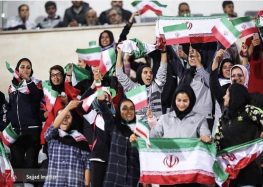Men and Women Required to Run Separately in Tehran’s First International Marathon

Spokesman Strays From State Line on Hijab
Despite interest expressed by foreign female runners, women participants in Tehran’s first international marathon will be required to run separately and on a shortened route.
The sudden change resulted in an admission by a sports official that the hijab—the head-to-toe Shia-Islamic dress code that all women in Iran are legally required to observe in public—is not always convenient.
Two days before the event on April 7, 2017, organizers decided that female runners would only be allowed to compete in a 10km race around the Azadi Lake west of Tehran, the state-affiliated Iranian Students’ News Agency (ISNA) reported.
Originally, the marathon route for all runners was designed to stretch from Azadi Stadium to Ferdowsi Square in central Tehran and back. Now women will be running a different route on the outskirts of the capital.
A spokesman for Iran’s Track and Field Federation, Hamid Sa’adat, told the Vaghaye Ettefaghiyeh newspaper on April 5 that the change was due to the hijab.
“We have limitations regarding the women’s marathon. It’s no joke to run 42 kilometers. We cannot tell the foreign runners to run that distance in a dress and headscarf. We are organizing this event in an Islamic country and we have to control every detail. We cannot hold this event within Islamic codes for women,” he said.
The admission that the hijab could present a hindrance to women was a diversion from an oft-repeated claim by officials of the Islamic Republic that the hijab offers protection for women rather than limitations.
Some 250 athletes from 44 countries have registered to take part in Friday’s “I Run Iran” marathon sponsored by Iran Silk Road, a website that claims to provide travel services for visitors to Iran.
According to its website, the marathon was “founded in Iran by Sebastiaan Straten, a Dutch entrepreneur and modern nomad.”
More than 50 female runners will compete in their hijab.
Iran’s first international marathon was held in April 2016 by the ancient ruins at Persepolis, near the city of Shiraz in south-central Iran. Two hours before it began, the only two female participants, both Iranian, were banned even though they arrived in a hijab.
In addition to a state-imposed ban on women spectators at sports events involving male competitors, the government’s strict interpretations of Islamic laws and norms also prevent Iranian women from participating in many sports events.
Last week, Iran’s Bowling and Billiards Federation banned a number of female billiard players from competing for a year after they were accused of violating the Islamic code of conduct while competing in China.
*This article was modified on April 8, 2017 to reflect that female runners were forced to run a shortened route.






